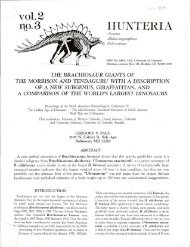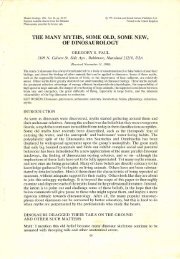THE SEGNOSAURIAN DINOSAURS: RELICS OF ... - Gregory S. Paul
THE SEGNOSAURIAN DINOSAURS: RELICS OF ... - Gregory S. Paul
THE SEGNOSAURIAN DINOSAURS: RELICS OF ... - Gregory S. Paul
You also want an ePaper? Increase the reach of your titles
YUMPU automatically turns print PDFs into web optimized ePapers that Google loves.
is not impossible, but can conservatively be considered<br />
unlikely. In the massiveness of digit I and its claw<br />
weapon, and in overall proportions the segnosaurian<br />
hindfoot is prosauropod, not theropod in grade (Fig.<br />
1). Early dinosaurs-lagosuchids and Herrerasaurusalso<br />
have a four-toed hindfoot, and many ornithischians<br />
retain this type (Fig. 1; Bonaparte, 1975; Reig,<br />
1963). Most thecodonts differ greatly from segnosaurs<br />
and dinosaurs in general in having more supple, plantigrade<br />
hindfeet with a large, divergent fifth digit.<br />
Skull- The segnosaur skull is also intriguing. It exhibits<br />
a kaleidoscopic blend of basal dinosaur, prosauropod,<br />
and ornithischian characters, but shows no distinctive<br />
theropod or thecodont attributes. The skull of<br />
Erlikosaurus shares with early theropods, prosauropods,<br />
and generalizedornithischians such general basal<br />
dinosaurian characters as a long, low profile, a tall,<br />
vertical quadrate, a slender tripronged jugal, a low triangular<br />
maxilla, and a broad lacrimal (Fig. 2). It also<br />
shares with early theropods and prosauropods an archaic<br />
archosaurian dentary-posterior mandible articulation<br />
in which the surangular overruns the dentary<br />
dorsally, and a slender quadrate process on both the<br />
squamosal and the quadratojugal (Fig: 2). That the<br />
skulls of the earliest representatives of the major predatory<br />
and herbivorous dinosaur groups-and the segnosaurs,<br />
too-are so similar both in overall design<br />
and in much of their detailed morphology is strong<br />
evidence ofdinosaur monophyly. In contrast, no known<br />
thecodont skull shares more than a few isolated dinosaur-like<br />
characters with any of the genera pictured<br />
in Figure 1. In fact, all thecodonts have a robust, fourpronged<br />
jugal, a short, broad lacrimal, and (except for<br />
aetosaurs and phytosaurs) a down and backwards sloping<br />
quadrate and (except for aetosaurs) a tall, rectangular<br />
maxilla (Fig. 2; Walker, 1961; Ewer, 1965; Romer,<br />
1972b).Becausethe segnosaurian skull also shares<br />
derived characters with both prosauropods and ornithischians,<br />
it further links these two groups together<br />
at a level above the thecodont grade.<br />
The prosauropod-like characters in the skull of Erlikosaurus<br />
include the snout which has a large, similarly<br />
shaped premaxilla with a deep narial shelf, large,<br />
very elongate external nares, and a similarly shaped,<br />
oni1tisclllrn theropod<br />
Hypsi/ophodan CoeJoptrys.s<br />
FIGURE 1. The left pes of basal dinosaurs and segnosaurs<br />
in anterior view. Metatarsal I in black. After Ruene (1907),<br />
Raath (1969), Galton (1974), Barsbold (1979), and Barsbold<br />
and Perle (1979,1980).<br />
508<br />
tall, triangular maxilla with a tall, short, deeply recessed<br />
antorbital fossa and fenestra (Fig. 2). The mandibles<br />
of Erlikosaurus and Plateosaurus share a downwardlycurved<br />
dentary, an anteriorly elongated splenial,<br />
a short, tongue-shaped prearticular, and a posteriorly<br />
deep mandible (Perle, 1979). In overall design and<br />
detailed morphology the skull of Erlikosaurus is remarkably<br />
similar to that of Plateosaurus. In build, the<br />
skull of Erlikosaurus is intermediate between the lightly<br />
built prosauropod and the stoutly constructed ornithischian<br />
skulls.<br />
Erlikosaurus does not have three characters that most<br />
ornithischians do have, a closed mandibular fenestra,<br />
a predentary, and a coronoid process. However, a mandibular<br />
fenestra is present in fabrosaurid ornithischians<br />
(Thulborn, 1970), and even the predentary is of<br />
questionable significance. It has not been positively<br />
established that such morphologically archaic ornithischians<br />
as Scelidosaurus, Parksosaurus, the pachycephalosaurs,<br />
or certain nodosaurs have a predentary<br />
(Owen, 1861; Gilmore, 1924; Brown and Schlaikjer,<br />
1943; Coombs, 1971; Galton, 1973b).<br />
Early theropods (Fig. 2) contrast sharply with segnosaurs<br />
in having a shallow narial shelf on the premaxilla,<br />
small external nares, a very large, long antorbital<br />
fenestra and a small, shallow antorbital fossa, a<br />
straight or upwardly curved dentary, short splenial,<br />
long prearticular, and a moderately deep posterior<br />
mandible. The segnosaurian skull simply fails to share<br />
any derived characters with any theropod group, including<br />
the known Cretaceous genera. All thecodonts<br />
differfrom segnosaurs in having a shallow narial shelf,<br />
a shallow or no antorbital fossa, and a straight or upcurved<br />
dentary (Fig. 2), and most thecodonts are predatory.<br />
Only aetosaurs differ from other thecodonts and<br />
share with segnosaurs and other herbivorous dinosaurs<br />
a deep posterior mandible, a large narial opening, and<br />
herbivory. However, aetosaurs differ from all the taxa<br />
discussed here in their aberrant "pig like" snout and<br />
constricted lateral temporal fenestra (Fig. 2).<br />
Feeding Apparatus-Ornithischians are distinguished<br />
from all other archosaurs in having a highly<br />
derived food gathering and processing apparatus (Galton,<br />
1973a). Food is cropped by a beak. Behind the<br />
beak, the presence of a mammal-like toothless space<br />
or diastema suggests that the food was shaped and<br />
passedbackwardsby a tongue supported by longhyoids,<br />
which positioned the foodstuffs in the tooth rows to<br />
be masticated. Food loss from the mouth was prevented<br />
by the cheeks (Fig. 2).<br />
Two key characters are directly associated with the<br />
presence of cheeks in those dinosaurs that have them ..<br />
One is the reduction of the rows of numerous, small<br />
foramina that supply nerves to the thin bands of cheek<br />
muscles (seen in lizards and most thecodonts, Fig. 2),<br />
into a few large foramina that pass large nerve bundles<br />
to the cheek muscles. The second character is the insetting<br />
of the tooth rows, so that they are bordered<br />
laterally by shelves which support the cheeks. The first<br />
character is the more important, because in mammals<br />
JVP 4(4), December 1984









